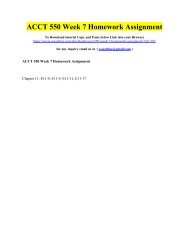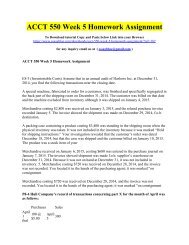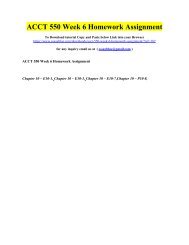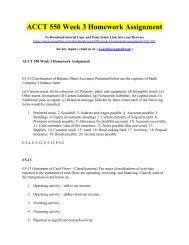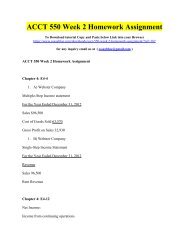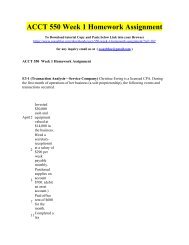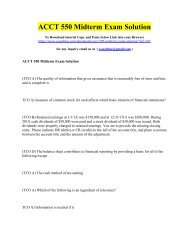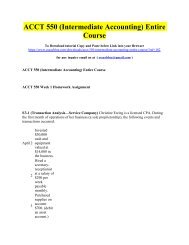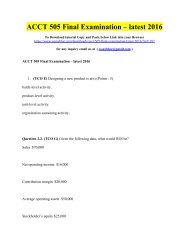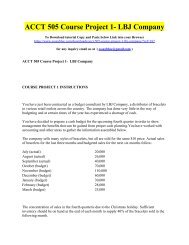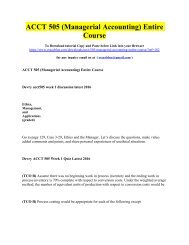ACCT 444 Week 3 Homework
ACCT 444 Week 3 Homework
ACCT 444 Week 3 Homework
You also want an ePaper? Increase the reach of your titles
YUMPU automatically turns print PDFs into web optimized ePapers that Google loves.
<strong>ACCT</strong> <strong>444</strong> <strong>Week</strong> 3 <strong>Homework</strong><br />
To Download tutorial Copy and Paste below Link into your Browser<br />
https://www.essayblue.com/downloads/acct-<strong>444</strong>-week-3-homework/?ref=182<br />
for any inquiry email us at ( essayblue@gmail.com )<br />
<strong>ACCT</strong> <strong>444</strong> <strong>Week</strong> 3 <strong>Homework</strong><br />
Chapter 7<br />
7-27 (Objective 7-4) The following are examples of documentation typically obtained by<br />
auditors:<br />
1. Vendors’ invoices<br />
2. General ledger files<br />
3. Bank statements<br />
4. Cancelled payroll checks<br />
5. Payroll time records<br />
6. Purchase requisitions<br />
7. Receiving reports (documents prepared when merchandise is received)<br />
8. Minutes of the board of directors<br />
9. Remittance advices<br />
10. Signed W-4s (Employee’s Withholding Exemption Certificates)<br />
11. Signed lease agreements<br />
12. Duplicate copies of bills of lading<br />
13. Subsidiary accounts receivable records<br />
14. Cancelled notes payable<br />
15. Duplicate sales invoices
16. Articles of incorporation<br />
17. Title insurance policies for real estate<br />
18. Notes receivable<br />
Required<br />
1. Classify each of the preceding items according to type of documentation: (1) internal or (2)<br />
external.<br />
.<br />
1. Explain why external evidence is more reliable than internal evidence.<br />
7-30 (Objective 7-4) Eight different types of evidence were discussed. The following questions<br />
concern the reliability of that evidence:<br />
Required<br />
.<br />
1. Explain why confirmations are normally more reliable evidence than inquiries of the client.<br />
.<br />
1. Describe a situation in which confirmation will be considered highly reliable and another in<br />
which it will not be reliable.<br />
.<br />
1. Under what circumstances is the physical observation of inventory considered relatively<br />
unreliable evidence?
1. Explain why recalculation tests are highly reliable but of relatively limited use.<br />
.<br />
1. Give three examples of relatively reliable documentation and three examples of less reliable<br />
documentation. What characteristics distinguish the two?<br />
1. Give several examples in which the qualifications of the respondent or the qualifications of<br />
the auditor affect the reliability of the evidence.<br />
1. Explain why analytical procedures are important evidence even though they are relatively<br />
unreliable by themselves.<br />
.<br />
7-31 (Objective 7-4) As auditor of the Star Manufacturing Company, you have obtained<br />
1. A trial balance taken from the books of Star one month before year-end:<br />
2. There are no inventories consigned either in or out.<br />
3. All notes receivable are due from outsiders and held by Star.<br />
Required<br />
Which accounts should be confirmed with outside sources? Briefly describe from whom they<br />
should be confirmed and the information that should be confirmed. Organize your answer in the<br />
following format:*
Chapter 8<br />
8-22 (Objective 8-7) Gale Gordon, CPA, has found ratio and trend analysis relatively useless as a<br />
tool in conducting audits. For several engagements, he computed the industry ratios included in<br />
publications by Standard and Poor’s and compared them with industry standards. For most<br />
engagements, the client’s business was significantly different from the industry data in the<br />
publication and the client automatically explained away any discrepancies by attributing them to<br />
the unique nature of its operations. In cases in which the client had more than one branch in<br />
different industries, Gordon found the ratio analysis no help at all. How can Gordon improve the<br />
quality of his analytical procedures?<br />
8-33 (Objectives 8-3, 8-7, 8-8) Your comparison of the gross margin percent for Jones Drugs for<br />
the years 2008 through 2011 indicates a significant decline. This is shown by the following<br />
information:<br />
A discussion with Marilyn Adams, the controller, brings to light two possible explanations. She<br />
informs you that the industry gross profit percent in the retail drug industry declined fairly<br />
steadily for 3 years, which accounts for part of the decline. A second factor was the declining<br />
percent of the total volume resulting from the pharmacy part of the business. The pharmacy sales<br />
represent the most profitable portion of the business, yet the competition from discount<br />
drugstores prevents it from expanding as fast as the nondrug items such as magazines, candy,<br />
and many other items sold. Adams feels strongly that these two factors are the cause of the<br />
decline.<br />
The following additional information is obtained from independent sources and the client’s<br />
records as a means of investigating the controller’s explanations:<br />
Required
1. Evaluate the explanation provided by Adams. Show calculations to support your<br />
conclusions.<br />
.<br />
1. Which specific aspects of the client’s financial statements require intensive investigation in<br />
this audit?<br />
.<br />
Chapter 9<br />
9-33 (Objectives 9-6) Below are ten independent risk factors:<br />
1. The client lacks sufficient working capital to continue operations.<br />
2. The client fails to detect employee theft of inventory from the warehouse because there are no<br />
restrictions on warehouse access and the client does not reconcile inventory on hand to recorded<br />
amounts on a timely basis.<br />
3. The company is publicly traded.<br />
4. The auditor has identified numerous material misstatements during prior year audit engagements.<br />
5. The assigned staff on the audit engagement lack the necessary skills to identify actual errors in an<br />
account balance when examining audit evidence accumulated.<br />
6. The client is one of the industry’s largest based on its size and market share.<br />
7. The client engages in several material transactions with entities owned by family members of<br />
several of the client’s senior executives.<br />
8. The allowance for doubtful accounts is based on significant assumptions made by management.<br />
9. The audit plan omits several necessary audit procedures.<br />
10. The client fails to reconcile bank accounts to recorded cash balances.<br />
Required<br />
Identify which of the following audit risk model components relates most directly to each of<br />
the ten risk factors:
Acceptable audit risk<br />
Inherent risk<br />
Control risk<br />
Planned detection risk



